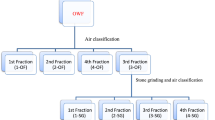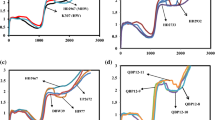Abstract
Chemical, rheological and parotta-making characteristics of wheat-milling flour streams were studied with the main aim of develo** a speciality flour for parotta. Important quality characteristics such as ash, flour colour, dry gluten content, sedimentation value, free and bound lipid content, farinograph and alveograph characteristics of the mill streams were determined. The studies showed an increase in ash, gluten content and sedimentation value with increasing numbers of breaks in the flour streams. An increase in percentage whiteness and bound lipids was observed in the first five reduction passages (C1 to C5). The alveograph characteristics indicated that the average abscissa at rupture (L) length of the curve increased with increasing reduction streams from C1 to C5, and also that the curves were better balanced when compared to 1 BK to 5 BK. The parottas made from the first five break passages had a decreased spread ratio, dull brown colour, and fused layers and lower overall quality score (43–79). The initial reduction streams (C1 to C5) produced good quality parottas in terms of appearance, spread, layers and texture. The shear force values indicating the texture of the product ranged from 1,120 to 1,250 g. The speciality flour made by combining C1 to C5 streams had 0.45% ash, 9.63% dry gluten, 45 ml sodium dodecyl sulphate sedimentation value, 0.7% free lipid and 1.8% bound lipid and produced parottas having creamish white colour, excellent pliability, thin, transparent and distinct layers, soft texture and moderate chewiness. In the mouth the parottas broke down easily, without leaving any residue. The overall quality score of parotta was highest (93.5) for the speciality flour when compared to break and reduction streams (43–77 and 56–92 respectively).


Similar content being viewed by others
References
Ministry of Information and Broadcasting (2001) India 2001. Publications Division, Ministry of Information and Broadcasting, Government of India, pp 445
Indrani D, Jyothsna Rao S, Udaya Sankar, Venkateswara Rao G (2000) Food Res Int 33:323–329
American Association of Cereal Chemists (2000) Approved methods of AACC, 10th edn. AACC, St. Paul, Minn
Morrison WR, Tan Sl, Haargin KD (1980) J Sci Food Agric 31:329–340
Pomeranz Y (1978) Wheat chemistry and technology. American Association of Cereal Chemists, St. Paul, Minn, pp 145
Ziegler E, Greer EN (1978) Principles of milling.Pomeranz Y (ed) In: Wheat chemistry and technology. American Association of Cereal Chemists, St. Paul, Minn., pp 115–199
Hinton JJC (1947) Proc R Soc London B 134:418
Kent NL (1966) Cereal Chem 43:585–589
Orth RA, Ohiver JR, Rayner CJ (1976) Food Technol 28:210–214
Morrison WR, Haargin KD (1981) J Sci Food Agric 32:575–587
Morrison WR, Coventry AM, Barnes PJ (1982) J Sci Food Agric 33:925–933
Holas J, Tipples KH (1978) Cereal Chem 55:637–652
Arya SS, Vanaja N, Parihar DB (1976) Role of lipids in chapathi baking. In: Proceedings of the symposium on fats and oils in relation to food products and their preparations. Association of Food Scientists and Technologists, India, pp 146–148
Author information
Authors and Affiliations
Corresponding author
Rights and permissions
About this article
Cite this article
Indrani, D., Rajiv, J., Prabhasankar, P. et al. Chemical, rheological and parotta making characteristics of flourmill streams. Eur Food Res Technol 217, 219–223 (2003). https://doi.org/10.1007/s00217-003-0741-0
Received:
Published:
Issue Date:
DOI: https://doi.org/10.1007/s00217-003-0741-0




